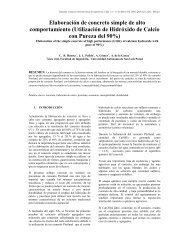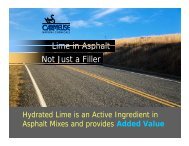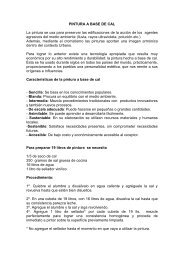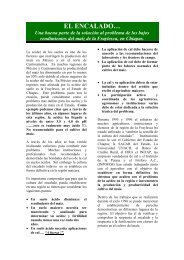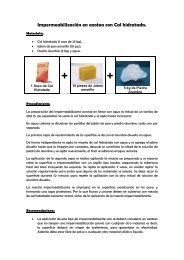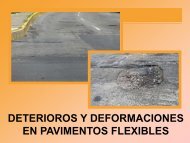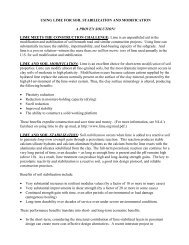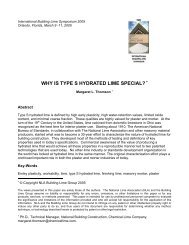Land Contamination: Technical Guidance on Special Sites: Acid Tar ...
Land Contamination: Technical Guidance on Special Sites: Acid Tar ...
Land Contamination: Technical Guidance on Special Sites: Acid Tar ...
You also want an ePaper? Increase the reach of your titles
YUMPU automatically turns print PDFs into web optimized ePapers that Google loves.
Dispersing by Chemical Reacti<strong>on</strong> (DCR)• This process works by using hydrophobic calcium oxide mixed with organiccomp<strong>on</strong>ents. The n<strong>on</strong>-aqueous comp<strong>on</strong>ents of the acid tars are selectively adsorbedwithin the calcium oxide, and the water c<strong>on</strong>tent of the acid tar reacts with the calciumoxide to give fine powdered calcium hydroxide. The c<strong>on</strong>taminant is therebyencapsulated within this system, being water repellent and leaching resistant;• as for other neutralisati<strong>on</strong> processes, DCR treatment can be applied with the materialexcavated and placed in layers, and the proprietary calcium oxide added usingmechanical equipment. However, this could have a significant space requirement.Alternatively, direct additi<strong>on</strong> may take place in situ, provided that the tars are suitablyshallow. The resultant material can potentially be used as fill (subject to leachingtests) or for road c<strong>on</strong>structi<strong>on</strong>;• there are several technical limitati<strong>on</strong>s to the process, including uncertainties regardingits permanence and the leachability of the treated material;• operati<strong>on</strong>al c<strong>on</strong>straints could include the area required for treatment and requirementsfor c<strong>on</strong>trol <strong>on</strong> emissi<strong>on</strong>s, together with significant health and safety issues raised bythe exothermic nature of the reacti<strong>on</strong>;• the durability of DCR treatment is likely to be better than for stabilisati<strong>on</strong> techniquesbased <strong>on</strong> cement. This is because, for DCR, the oils can be pre-distributed through thecalcium oxide prior to effecting the hydrati<strong>on</strong> reacti<strong>on</strong>, thereby eliminating oil as aliquid phase. The hydrati<strong>on</strong> reacti<strong>on</strong> forms calcium hydroxide, which has a highspecific surface area. The oil is adsorbed <strong>on</strong>to the hydroxide in molecular thicknessand this is c<strong>on</strong>sidered by some to be virtually irreversible short of dissolving thecalcium hydroxide substrate (Grajczak (1995));• in the above reference, menti<strong>on</strong> is made of applicati<strong>on</strong> of DCR to acid tars in Germanywhere the subsequent product was disposed in an unlined cell and with apparently nodetectable c<strong>on</strong>taminati<strong>on</strong> in groundwater some 15 years later;• in c<strong>on</strong>trast, approaches based <strong>on</strong> cementati<strong>on</strong> normally aim to produce a m<strong>on</strong>olith withoil held as liquid phase droplets within the cementitious matrix. In this case, the l<strong>on</strong>gtermintegrity depends <strong>on</strong> that of the matrix.R&D <str<strong>on</strong>g>Technical</str<strong>on</strong>g> Report P5-042/TR/04 36



